Synaptics Unveils Clear ID In-Display Fingerprint Sensor for 18:9, 20:9 Smartphones
by Anton Shilov on December 14, 2017 1:00 PM EST- Posted in
- Smartphones
- Android
- Synaptics
- AMOLED
- Security
- Biometrics
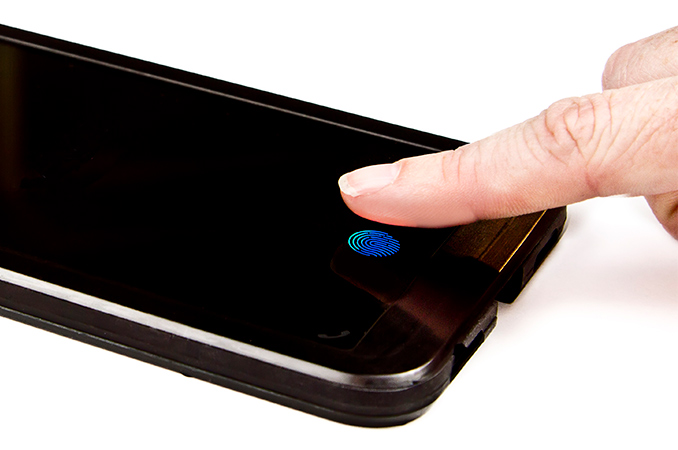
Synaptics this week introduced its first Clear ID FS9500 in-display optical sensor that can be installed under the surface of an OLED screen. The fingerprint reader works faster than facial recognition and can be used in any environments, including dark rooms and sunny beaches, Synaptics says. The first smartphones featuring the technology are due in Q1 2018.
Biometric authentication has become a mandated feature of every smartphone in the recent years, but integrating fingerprint sensor has become a challenge as screen-to-body ratio is growing and many front panels have no space for the reader. Some smartphone makers install fingerprint sensor on the back panels of their devices, other, like Apple, introduce facial recognition technologies that require IR and RGB sensors accompanied by appropriate processing resources. Synaptics argues that fingerprint sensors on the back are uncomfortable to use, whereas facial recognition technologies are relatively slow and can be fooled. By contrast, Synaptics’ latest Clear ID FS9500 sensor is hidden under the screen on the front and it works as fast as users come to expect from similar devices in the recent years.
The Synaptics Clear ID FS9500 fingerprint sensor is a tiny CMOS device that sits below the AMOLED display assemly and captures the reflected fingerprint between and through the OLED pixels. Synaptics said that the captured fingerprint has a very high resolution, but naturally does not quantify this claim. To make a fingerprint reflect, a part of the screen has to be lit-up, so while the device itself only uses 80 mA, the screen consumes some additional power too (Synaptics does not disclose the lowest brightness level of the display required for scanning as it depends on many factors). Meanwhile, Synaptics uses accelerometers and other sensors inside the phone to activate the sensor and turn on an appropriate area on the screen. The activation happens instantly, then it takes 0.7 seconds to scan the fingerprint, match it and grant or deny access. By contrast, Synaptics says, it takes modern smartphones about 1.4 seconds to scan a face.
The SF9500 does not support Match-In-Sensor technology, so the matching is performed by host using Synaptics’ Quantum Matcher software. It is noteworthy that the software Synaptics supplies with its sensors is quite complex. Apart from matching, the software is responsible for activating the reader and the screen whenever the phone is touched and for other things (like taking into account outside conditions that may affect minutiae). The new fingerprint sensor from Synaptics connects to host using the SPI bus. Depending on application and requirements, device manufacturer may choose to use an AES-encrypted SecureLink interface (e.g., if the SF9500 is installed into a bezel-less tablet, or a laptop display) if required.
The Clear ID FS9500 is “smart” enough to detect fingerprints in sunlight and bright conditions, take into account wet and/or cold fingers, detect spoofed fingerprints and so on. It remains to be seen how the sensor behaves when individual light-emitting pixels burn-in over time, but since Synaptics has a robust program stack supplied with its sensors, it can tweak them using software to compensate for screen degradation.
According to Synaptics, the Clear ID SF9500 sensor itself is only 0.69 mm thick and its integration does not make smartphones significantly thicker. The sensor integration process has to be performed by the screen manufacturer at a fab where display assemblies are made and Synaptics is working with appropriate makers. The process is not very complex, so it does not make final devices considerably more expensive, says the developer.
Synaptics initiated mass production of its Clear ID FS9500 sensors this month and will start their commercial shipments in the coming weeks. The company says that the first smartphone that uses the in-display fingerprint reader will be available in early 2018. Synaptics naturally does not disclose the manufacturer of the device, but only says that it is one of the Top 5 smartphone suppliers. Meanwhile, since the FS9500 sensor only works with OLED screens, this big producer of the smartphones has to have access to the AMOLED technology. Synaptics plans to showcase the handset at CES, but it is unclear whether the device will have been announced by that time, or Synaptics will show it camouflaged. Anyway, the first smartphone featuring the FS9500 is incoming and it will be available soon.
Related Reading:
Source: Synaptics


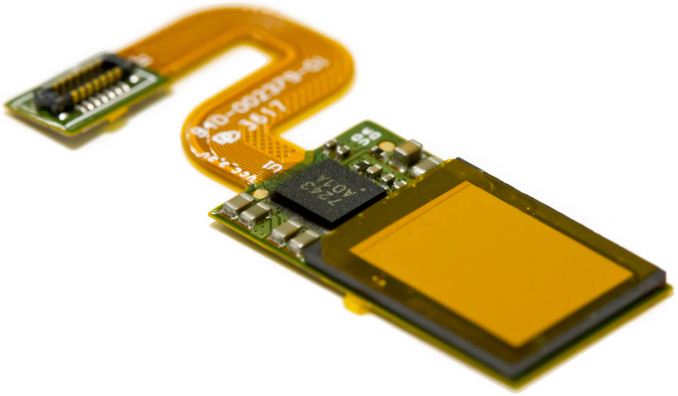
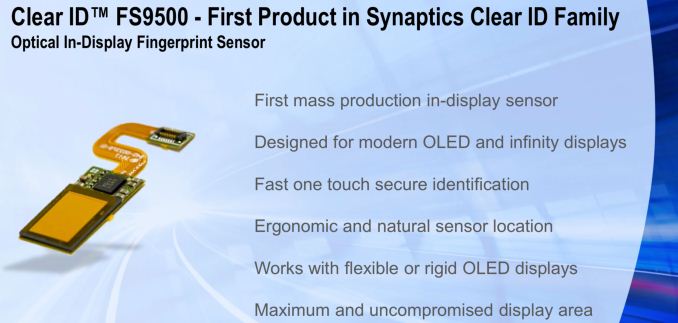
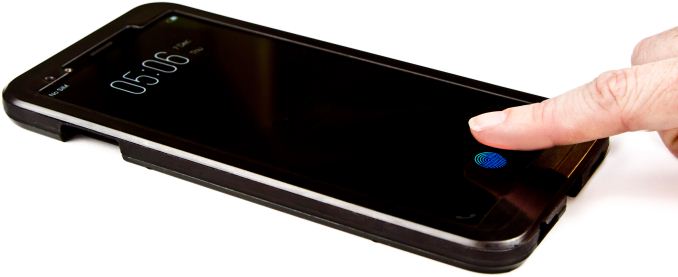
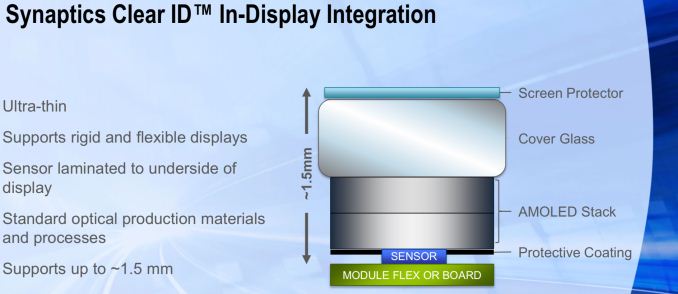








39 Comments
View All Comments
FullmetalTitan - Friday, December 15, 2017 - link
There has to be an award somewhere for the person who posts the largest quantity of incorrect forum responses in a year. There is no other justification for ddriver's existence.ddrіver - Saturday, December 16, 2017 - link
FullmetalTitan, I've seen more intelligent comments on CNN.ddrіver - Saturday, December 16, 2017 - link
I'm going to make it as simple as I can make it, just for you: they are imaging A REFLECTION ON A FLAT SURFACE. The article says "captures the reflected fingerprint". Can you imagine how a flat reflection can turn into a 3D image?This is the exact article posted on other sites so we can assume it's actually coming from the manufacturer, do you see any mention of 3D? Do you think Synaptics would forget that they have this capability?
jordanclock - Thursday, December 14, 2017 - link
That's because biometrics are only one part of a proper authentication process. It is a "who you are" requirement that should be augmented with a "what you know" or "what you have" aspect. I wish I could set my phone to require a fingerprint and a PIN OR a really long password without fingerprint.PeachNCream - Thursday, December 14, 2017 - link
Yeah, I totally agree which is why I said I don't like it as the only factor in authentication which was to imply multi-factor that included it was a better option. Even then, I still think using something that can't be changed ever is a bad idea and its typical inclusion in a multi-factor authentication mechanisms is asking for problems in the future when people figure out how to exploit those systems.Samus - Thursday, December 14, 2017 - link
Wow, I couldn't see myself using a device without a fingerprint sensor. I hate passwords. My Apple Watch actually unlocks my Mac when I walk up to it.Devo2007 - Thursday, December 14, 2017 - link
Wonder if this will make screens harder to replacejjj - Thursday, December 14, 2017 - link
Short term maybe yes, long term no.Synaptics has the habit to integrate. Right now they are integrating the display driver and the touch controller (they call it TDDI) and in the future they'll also integrate the fingerprint and maybe more.
edzieba - Thursday, December 14, 2017 - link
The downside is you no longer have the fingerprint sensor on the back. Where it should be.piroroadkill - Friday, December 15, 2017 - link
I have a phone with one on the back, and honestly I think one on the front would be better - easier to unlock while the phone sits on a table...